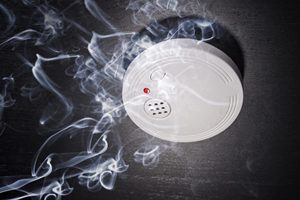 Anyone who’s anyone knows how important fire detectors are, and most people know that carbon monoxide detectors are extremely important too. Not everyone knows exactly where to put them, but that’s a topic for another time. That’s because today, I want to talk about just how many choices you have when it’s time to replace your detectors.
Anyone who’s anyone knows how important fire detectors are, and most people know that carbon monoxide detectors are extremely important too. Not everyone knows exactly where to put them, but that’s a topic for another time. That’s because today, I want to talk about just how many choices you have when it’s time to replace your detectors.
Did you know that there are different kinds of fires, and some detectors won’t detect them all? Did you know various detectors can communicate with each other?
There’s a wide, wild world of amazingly smart carbon monoxide and fire detectors out there! Before you head to the store, check out these tips so you can make a better choice at the checkout counter.
Did you know there are two different kinds of fires?
And not all smoke detectors can effectively detect both. When it comes to fast, flaming fires, ionization smoke alarms are the best, but they stink at detecting smoldering fires. These are the smoke detectors that overreact every time you’re in the kitchen.
If you want to protect yourself against smoldering fires, or you’re tired of the smoke alarm sounding every time you fry up some bacon, opt for a photoelectric smoke alarm. Unfortunately, these alarms aren’t too keen on sounding if there’s a fast, flaming fire.
Don’t want to worry about installing two smoke alarms? Opt for a dual-sensor alarm. These can effectively detect both kinds of fires.
As you can see, a smoke alarm definitely isn’t just a smoke alarm!
Combination CO and smoke alarms
You’re probably wondering about carbon monoxide detectors, because you need those too, right? But you’re probably also wondering just how many detectors you’re going to need. Your ceiling will end up covered in them!
That’s where the combination CO and smoke alarm comes in. That sounds great! One device can replace two, or even three? Sorry, but the technology isn’t quite there yet. Let me tell you what I mean.
Current combination alarms may detect a fire and carbon monoxide, but they are unable to detect both flaming and smoldering fires, so you’re going to end up with two detectors anyway. If you want to detect both kinds of fires with the same device, you’re going to have to buy a separate CO detector. Hopefully, manufacturers will come up with a much better all-in-one solution in the future.
Some carbon monoxide and fire detectors can talk to each other
Feeling disappointed because CO and fire detectors aren’t as smart as you expected? Current alarms may have some downsides, but they’re getting smarter every day.
Some carbon monoxide and fire detectors can be integrated, which means they can talk to each other. In the past, that meant linking them with wires, but today, you can get your hands on wireless units. If one alarm sounds, it quickly communicates with the other alarms in the home, sounding them all at the same time. This is an especially good feature if you have a large home with multiple levels.
Other smart alarm features
There are many specialty alarms to choose from as well, depending on the needs of you and your family that include:
- Strobe light alarms are great for the hearing impaired because they utilize a strobe light alarm
- Voice alarms use a voice instead of an alarm; this is an unexpectedly great choice for kids
- Alarms with safety lights can illuminate the path to safety at night
Add a smoke alarm or carbon monoxide detector to your home security system
If you really want your smoke alarm and carbon monoxide detectors to work hard for you and your family, there’s nothing better than adding smoke and CO detectors to your home security system.
Most providers offer this option. For example, Protect America, offers a smoke detector that can be added to any security system plan.
The advantage of integrating your detectors is that when the alarm is sounded, an alarm is also sent to your home security provider if you have professional monitoring. If there’s an emergency, police, and firefighters will be on their way before you can even reach for the phone.
Even if you don’t have professional monitoring, the alarm can send you an alert on your smartphone, so you can be aware of a fire or a CO emergency even when you’re not at home.
If an alarm sounds and no one is there to hear it, does it still make a sound?
Just a little joke. Well, kind of.
It can certainly mean disaster if your house is left to burn to the ground because no one was at home to be aware that there was a fire.
Making an informed choice
The key is making sure that you think carefully about your choices before purchasing a new fire or carbon monoxide detector. We’re here to help keep your family as safe as possible, even if it means plastering your ceiling with all the right detectors until an all-in-one, fully integrated smart unit is finally invented.
If you’d like to integrate your detectors with a home alarm system, make sure you browse our top providers.




